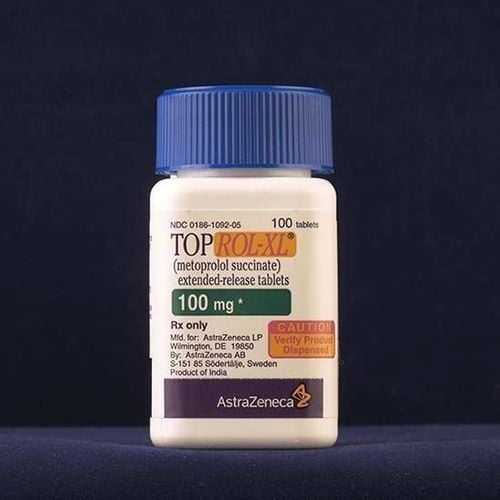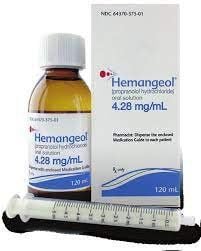This is an automatically translated article.
The article was professionally consulted with Specialist Doctor I Nguyen Duc Thong - Anesthesiologist - General Surgery Department - Vinmec Danang International General Hospital.Emla 5 drug is prepared as a topical medication, with the main active ingredients being Lidocaine and Prilocaine. Medicines are used to numb before performing surgical procedures.
1. Uses of the drug Emla 5
What is Emla 5? Emla 5 medicine has the composition of 25mg/g Lidocaine and 25mg/g Prilocain and other excipients. Emla 5 is a topical cream - a local anesthetic of the amide group. When absorbed through the epidermis and skin, the drug has an anesthetic effect on the skin. The level of anesthesia depends on the site of application and the dose used.Effects of drug ingredients Emla 5:
Lidocaine: Belongs to the group of local anesthetic active ingredients, the essence is 1 amide. Some other names for Lidocaine are: Xylocaine, lignocaine. Using Lidocaine in high doses has a long-lasting anesthetic effect; In small amounts, it has a temporary numbing effect, reducing the sensitivity of the nerves that conduct nerve impulses in the body. In addition, Lidocaine also reduces premature ejaculation by reducing sensitivity at the tip of the penis to prolong sexual intercourse. Prilocaine: Belongs to the group of local anesthetic active ingredients, with similar chemical structure to amino acids. Prilocaine is often combined with lidocaine to numb the skin, numb the wound. Prilocaine also helps to reduce premature ejaculation due to physiological weakness. Indications of the drug Emla 5:
Anesthesia of the skin surface in needle threading and superficial surgical procedures; Topical anesthesia of leg ulcers before cleaning, performing superficial surgical procedures (eg, removal of fibrin, pus, and necrotic substances). Anesthesia of the genital mucosa. Contraindications of the drug Emla 5:
People with hypersensitivity to anesthetics of the Amid group or excipients of the drug; Premature babies (born before 37 weeks of pregnancy).
2. How to take Emla 5
Instructions for using Emla 5 are as follows:Apply numbing cream to the area of the skin that needs to be used (for example, when preparing for a procedure in any skin area, apply the cream there). Peel off the paper from the center cut of the non-adhesive side of the dressing; Place the bandage carefully on the area where the Emla cream is applied, taking care not to spread the cream under the bandage; Remove the paper backing, carefully smoothing the tape edges; Leave in place for a minimum of 60 minutes if skin is not damaged. *Note: The cream should not be left in place for more than 60 minutes in infants under 3 months of age or for more than 30 minutes in children with atopic dermatitis. In addition, the opened tube can only be used once, so the excess cream should be discarded after each procedure.
3. Dosage of Emla 5
3.1 In adults On healthy skin:Insert a needle into a vein, take a blood sample: Use a dose of 1⁄2 tubes of cream (about 2g) on an area of 10 cm2. Apply a thick layer of cream to the skin, cover with tape. Application time is 1 - 5 hours; Small superficial surgical procedures such as curettage of molluscum contagiosum: Use a dose of 1.5 - 2g over an area of 10cm2. Apply a thick layer of cream to the skin, cover with tape. Application time is 1 - 5 hours; Superficial surgical procedures on larger areas such as skin grafts: Use a dose of 1.5 - 2g over an area of 10 cm2. Apply a thick layer of cream to the skin, cover with tape. Application time is 2 - 5 hours; On a large area of newly shaved skin (outpatient treatment): The maximum dose is 60g, the maximum area of cream application is 600 cm2. Application time is 1-5 hours. On leg ulcers:
Perform foot ulcer hygiene: Use a dose of about 1-2g on an area of 10cm2. Apply a thick layer of cream to the surface of the ulcer, do not use more than 10g at a time, cover the ulcer with a bandage. When opening the vial cap, use it only once; Emla 5 application time: Minimum 30 minutes; For foot ulcers that are difficult to absorb: The application time can last up to 60 minutes. Cleaning of the ulcer should be started within 10 minutes of wiping off the applied cream. In the genital tract:
On the skin: Use before local anesthetic injection. For men using a dose of 1g on an area of 10 cm2, apply a thick layer of cream to the skin, the application time is 15 minutes. For women, use a dose of 1-2g on an area of 10 m2, apply a thick layer of cream to the skin, the application time is 60 minutes; Genital tract mucosa: To remove condyloma (warts) or before local anesthetic injection, a dose of 5 - 10g is used depending on the treatment area. Note that the drug must be applied to the entire surface, including the mucosal folds, without the need for a tight bandage. The application time is 5-10 minutes and surgery must be performed immediately after wiping off the cream. 3.2 In children When inserting needles, scraping lesions due to molluscum contagiosum or other minor surgical procedures: Use a dose of 1g over an area of 10 cm2. If a thick layer of cream is applied to the skin, covered with a bandage, the dose should not exceed 1g/10cm2 and should be adjusted according to the area of application.
Adjust the dosage in children:
Children 0 - 3 months old: Maximum application area 10 cm2, maximum total dose 1g/day. The maximum application time is 1 hour; Children 3 - 12 months old: Maximum application area 20 cm2, maximum total dose 2g/day. Application time is 1 hour; Children 1 - 6 years old: Maximum application area 100 cm2, maximum total dose 10g/day. Application time is 1 - 5 hours; Children 6 - 12 years old: Maximum application area 200 cm2, maximum total dose 20g/day. The application time is 1 - 5 hours. *Note: After applying the drug for a long time, the anesthetic effect will decrease. In addition, for children with atopic dermatitis, the application time should be reduced to 30 minutes.
Overdose: When Emla 5 is used at the recommended dose, systemic toxicity is unlikely. When there is a toxic event, the patient's symptoms may include: CNS excitation, CNS depression and myocardial depression. In some cases, clinically significant methaemoglobinemia occurred. In case of methaemoglobinemia in overdose, the patient should be treated immediately.
4. Side effects of the drug Emla 5
When using Emla 5 drug, patients may experience some side effects such as:Common: Transient reactions at the application site such as pale blue, redness and edema, feeling of heat, itching or warmth at the injection site; Uncommon: Feeling of mild heat when applying the drug, itching, paresthesia at the application site such as tingling, local skin irritation; Rare: Allergic reactions (the most severe is anaphylaxis), methaemoglobinemia, skin reactions at the application site (rash or purpura), corneal irritation (if the drug gets into eyes).
5. Be careful when using Emla 5
Some notes to remember before and while using Emla 5 drug:Patients with G6PD deficiency or congenital or idiopathic methaemoglobinemia syndrome are at high risk of methaemoglobinemia due to Emla 5; Studies have not shown the effectiveness of Emla 5 for heel injection in infants; Use caution when applying Emla 5 near the eye area, as it may cause eye irritation. In addition, the loss of protective reflexes can cause corneal irritation, eye abrasions. If eye contact occurs, immediately flush eyes with water or sodium chloride solution, protect eyes until sensation returns; Be careful when using the drug on the skin area with atopic dermatitis, should reduce the application time to 15 - 30 minutes. Applying the drug for more than 30 minutes to people with atopic dermatitis may increase the risk of local vascular reactions, especially redness at the application site, even rash and purpura; Emla 5 cream should be applied approximately 30 minutes before excision of molluscum contagiosum in children with atopic dermatitis; In children under 3 months of age, the safety and effectiveness of the drug have only been studied in single-dose cases. In this group of children, a transient increase in methaemoglobin levels is usually noted up to 13 hours after application of Emla 5. Close monitoring and ECG monitoring is recommended in patients receiving class III antiarrhythmic drugs (see section 4.4). such as amiodarone) because of possible additive effects on the heart; Emla 5 should not be used on damaged eardrums or other conditions that could cause it to seep into the middle ear; Emla 5 should not be used on open wounds; Emla 5 should not be used on the genital mucosa in children; Lidocaine and Prilocaine have antibacterial and antiviral properties at concentrations above 0.5 - 2%. Therefore, it is advisable to monitor the results of intradermal injections for vaccines containing live bacteria; Emla 5 should not be used in children aged 0 - 12 months who are being treated concomitantly with drugs that cause methaemoglobinemia; Use caution when using Emla 5 in pregnant and lactating women; Emla 5 topical cream contains macrogolglycerol hydroxystearate, which may cause skin reactions.
6. Emla 5 . drug interactions
Some drug interactions of Emla 5 include:The drug Emla 5 may aggravate the formation of methaemoglobin in people being treated with methaemoglobin-inducing preparations such as: sulfonamides, benzocaine, chloroquine, dapsone, metoclopramide, acetanilide, dyes aniline, naphthalene, nitrates and nitrites, nitrofurantoin, nitroprusside, nitroglycerin, pamaquin, para-aminosalicylic acid, phenobarbital, phenytoin, phenacetin, primaquine, quinine,...; When high doses of Emla 5 are used, the systemic additive effect should be considered in patients receiving local anesthetics or drugs structurally similar to local anesthetics such as tocainide; Use caution when combining Lidocaine/Prilocaine with class III antiarrhythmic drugs (eg, amiodarone); Drugs that decrease lidocaine excretion, such as cimetidine or beta-blockers, can increase blood levels of lidocaine to toxic levels if high doses of lidocaine are used repeatedly over a long period of time. These interactions are not clinically significant if lidocaine is treated for a short period at the recommended dose. Emla 5 drug is a topical anesthetic cream, which can cause some side effects such as rash, burning,... If there are any abnormal manifestations, the patient should notify the doctor immediately for treatment. timely support and treatment.
Follow Vinmec International General Hospital website to get more health, nutrition and beauty information to protect the health of yourself and your loved ones in your family.
Please dial HOTLINE for more information or register for an appointment HERE. Download MyVinmec app to make appointments faster and to manage your bookings easily.














